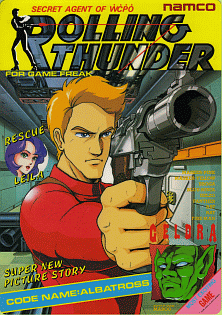Rolling Thunder (arcade game)
| Rolling Thunder | |
|---|---|

Japanese arcade flyer
|
|
| Developer(s) |
Namco Arc System Works Tiertex U.S. Gold |
| Publisher(s) |
|
| Composer(s) | Junko Ozawa |
| Series | Rolling Thunder |
| Platform(s) | Arcade, Amiga, Amstrad CPC, Atari ST, Commodore 64, Family Computer/NES, ZX Spectrum, Atari Lynx (cancelled) |
| Release date(s) |
Arcade
Commodore 64
Amiga
|
| Genre(s) | Run and gun |
| Mode(s) | Single player, up to 2 players (alternating turns) |
| Cabinet | Upright, cabaret, and cocktail |
| Arcade system | Namco System 86 |
| CPU | 2x Motorola M6809 @ 1.536 MHz, 1x Hitachi HD63701 @ 1.536 MHz |
| Sound | 1x Yamaha YM2151 @ 3.57958 MHz, 1x Namco CUS30 @ 96 kHz, 1x Namco 63701X @ 6 MHz |
| Display | Horizontal orientation, Raster, 288 x 224 resolution |
Rolling Thunder (ローリングサンダー Rōringu Sandā?) is a side-scrolling action game produced by Namco (now known as Bandai Namco Entertainment) originally released in as a coin-operated arcade game which ran on the Namco System 86 hardware. It was distributed internationally outside Japan by Atari Games. The player takes control of a secret agent who must rescue his female partner from a terrorist organization. Rolling Thunder was released for various computer platforms in 1987 and the Family Computer and Nintendo Entertainment System in 1989. The original arcade game has also been included in various classic game compilations as well.
The player takes control of Albatross, a member of the WCPO's (World Crime Police Organization) "Rolling Thunder" espionage unit. Albatross's mission is to save a missing female agent named Leila Blitz from a secret society named Geldra located in New York.
Albatross must travel through two different segments or "stories", each composed of five stages, for a total of ten stages. Depending on the DIP switch settings, the player has the option to start the game from any point in "Story 1" (allowing the player to skip any of the first four stages if desired). On each stage, the player can enter doors to hide and take cover from enemies, as well jump over to higher or lower floors with rails, including stairs. The stages in "Story 2" are essentially harder versions of their "Story 1" counterparts, featuring more traps and different enemy placement. At the end of each stage, scenes from Leila's capture and ensuing torture are shown on a large monitor screen.
...
Wikipedia
